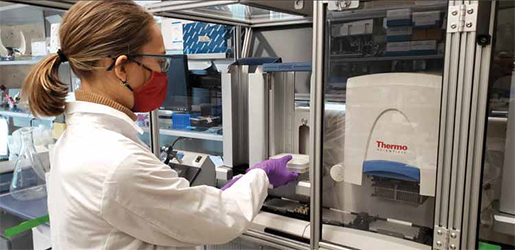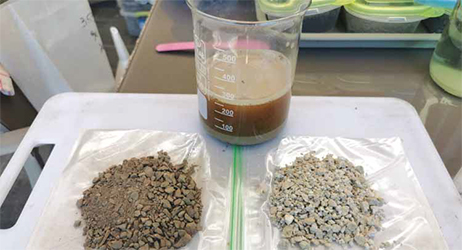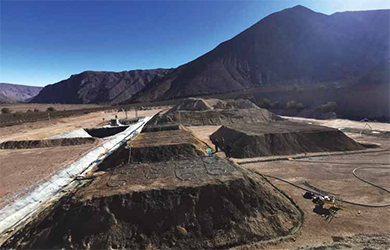
Purification of microbial DNA on the Agilent Bravo automation system. (Photo: UBC)
Copper Production: Mining Must
‘Follow the Science’
Some new science-based initiatives could prove game changing in copper recovery
By Carly Leonida, European Editor

According to a briefing from energy research consultancy, Wood Mackenzie, to achieve an accelerated energy transition with a below 1.5° temperature rise globally will require an additional 19 million tons of copper to be produced by 2040. The majority will need to come from uncommitted projects, which will be diffi- cult, if not impossible, given the energy and water-intensity of current extraction processes and the number of related challenges projects face today in permitting. It’s clear that to keep pace with growing demand for copper and other metals, mining companies need to work together with vendors and academia to develop processing and recovery techniques that better align with future expectations around responsible mineral extraction.
Introducing Mining
Microbiome Analytics Platform
A raft of interesting projects and technologies
are currently in development that
embody this philosophy.
The Bradshaw Research Initiative for
Minerals and Mining (BRIMM) at the
University of British Columbia (UBC) is
helping to coordinate a C$15 million
($11.9 million) public-private partnership
along with project lead, Teck, and
the British Columbia Digital Technology
Supercluster (funded by the Canadian
Federal Government). The aim is to create
a mining microbe genome library and
data analytics platform to accelerate the
development of biotechnology applications
in mining.
The Mining Microbiome Analytics Platform (MMAP), which is essentially the mining equivalent of the Human Genome Project, started out with a philanthropic donation from BRIMM’s namesake, Dr. Peter Bradshaw, who had a vision of bringing people together from different disciplines to solve some of the bigger problems the mining industry faces.
Following a period of consultation with researchers across UBC, BRIMM brought together a team, led by Dr. Susan Baldwin, professor of chemical and biological engineering, and Dr. Steven Hallam, professor of microbiology and immunology. A webinar was held to showcase the initiative, which caught the eye of Teck Chief Innovation Officer Kalev Ruberg, who also sits on the board of BRIMM. The project aligned with some of the pioneering microbial-based process development — including treating selenium in mine water — that Teck has been leading for the past decade. The teams agreed to work together, and things snowballed from there. More partners were added to what has become a consortium, including Rio Tinto, BGC Engineering, Koonkie, Allonnia, Genome BC, and the Centre for Excellence in Mining Innovation (CEMI), with a common vision of developing a comprehensive fingerprint of microorganisms in all areas of mining.
The project received its official announcement on December 7, and E&MJ caught up with the UBC team to find out more about the myriad potential benefits, including in copper processing. Professor John Steen, director of BRIMM, explained: “In the initial consultation phase, Steven ventured the idea of creating a ‘library’ cataloging the genomic sequences of mining microbes. We all agreed it was a great idea, but it was fairly small scale. What Teck brought was the opportunity to scale that.”
Teck was an early adopter of genomics and its relationship with UBC stretches back to 2007 when Hallam and Baldwin ran one of the first genomics project involving a mining company. Baldwin said: “Back then, bringing the mining industry into our research was a completely wild idea. Nobody thought that there could be genomics associated with mining, but Teck had that vision. It provided some support for that grant and had a lot of success with it.
“We’ve recently become more convinced of how heavily micro-organisms are involved in mining processes. The minerals that we mine were formed by geological and micro- biological processes thousands of years ago. Micro-organisms are also involved in the weathering of rocks, and we know that they’re important for remediation. They’re involved at every stage of the mine lifecycle from exploration to extraction, to waste. We want to do a comprehensive survey of those organisms to better understand them.”

Creating Map of Microbial
Activity
In its first phase, MMAP is aiming to create
an inventory of micro-organisms and their
genomic information based on a minimum
of 15,000-20,000 samples taken from
mine sites initially in Canada and the United
States and, over time, across the globe.
Once a database has been established, it
will then be possible to map microbe actions
across mine settings, conditions and
applications to identify different use cases
and opportunities for biotechnologies.
Bioinformatics specialist, Koonkie, is
supplying much of the computational
expertise for MMAP. Applying advanced
analytics, like machine learning, will turbo-
charge the insights that industry and
researchers alike can get from the database
or library.
“The technology will allow us to innovate organically and assemble use cases that leverage knowledge of the network,” Hallam said. “Nature has evolved these solutions; the microbes have all the biochemistry worked out. We have to discover the rules that they use to then apply them at scale. “Of course, we can’t see any of this. The microbes are invisible to the human eye, so the computers are like our microscopes. Statistical methods and models based around machine learning will allow us to make predictions around the presence and actions of certain microbes in different settings, and the more information we have that is trustworthy and validated, the better those predictions will get.”
Steen invoked a well-known example to illustrate the power of such a database: “It’s like the Amazon database of customer behavior,” he said. “They know exactly what their customers will do next, because they have a massive database of information on the behavior of purchases. That is the power that you get through a platform like this when you put more and more data through it, and that’s where the commercial value comes too. We’re hoping to create a similar database but for microbial behavior.”
The UBC team, in conjunction with MMAP member BGC Engineering, is training the project’s mining company partners to collect samples in a standardized way to ensure good data quality from the get-go. “Teck was already collecting this data; this is not new to them. But some others need a little more support,” explained Baldwin. “Every company has its own sampling methods, so the challenge has been in standardizing that approach so that we can compare the data. We have a very thorough process for developing site-specific sampling plans. For the most part, the mining companies will be collecting their own samples, either by themselves or through consultants. We provide oversight and then, once we have the samples, Steven and his group will analyze and catalog them.”
Sampling will take place across a broad set of mine sites, commodities and use cases from the outset, including both active and legacy sites. Steen said: “At the moment, we’re working at sites across North America, but we’re in conversation to expand that reach to sites in South America and Australia as well. Obviously, there are some commodities that are more important than others, copper and iron ore, for instance, but there has been a surge of interest across all commodities.”
Moving Into Action
MMAP is currently in phase one. Initial
samples are coming in for DNA extraction
and genomic sequencing, freezers are
being added to store them, laboratories
stocked, and platform software development
is under way.
MMAP’s founding members, which, along with the Supercluster, are providing the first $16 million of funding to develop and populate the platform, will naturally be the first to benefit from its findings. The consortium expects to have a working prototype by late 2022 and will then invite other entities to support the initiative. Once the platform is fully built out, the team hopes to provide insights through a software-as-a-service model. For instance, a company might need to remediate a legacy mine site or improve the outcomes from its leaching operation and could pay to access the library and glean insights into microbes that could generate a sustainable solution. Revenues will go back into the consortium to increase the research base, which benefits all parties.
Of course, MMAP will generate thousands of potential use cases for its findings across different commodities. One particular project, which began prior to MMAP, but could potentially be accelerated by its findings, is the carbonation of mine tailings. Most tailings don’t capture carbon (only mafic and ultramafic mineral species exhibit this tendency naturally). However, if a bacteria could be found that carbonates most mineral hosts, then it could be a game changer in the fight against global temperature rises.
Another area that’s receiving a lot of interest are rare earth elements (REEs) and improving ways to isolate and extract these. Microbiology offers a wealth of knowledge around selective metal binding and recovery. The rehabilitation of closed mine sites and waste dumps can also, in many cases, be managed or improved through harnessing the local microbiome.
Improving Bio-hydrometallurgy
Applications
While there will be plenty of new applications,
there are also opportunities to
improve existing bio-hydrometallurgical
processes too.
Dr. Wenying Liu, associate professor of
materials engineering at UBC, explained:
“Bio-leaching has been used for many
years for treating secondary sulphides at
copper operations. In Chile and Peru, for
example, it’s used at very high-altitude
mine sites. At 4,400 meters above the sea
level, the air pressure is only 58%-60%
of that at sea level. It’s hard to successfully
operate biological processes operations
under those conditions and we could
potentially learn a lot from sampling and
sequencing the microbes present.”
Certain microbes can be used to create permeability within ore, which is useful in improving recovery from heap leach applications in copper, and another very important application lies in copper concentrate treatment, especially for chalcopyrite. “Microbiology has a vast potential, not just in existing heap bioleaching operations, but also in-situ leaching in the future,” Liu explained. “Mining companies are familiar with bio-hydrometallurgy, but many are hesitant to embrace it, mainly due to lack of knowledge around control, efficiency and maintenance.” Another challenge is slow kinetics. With a high temperature, high pressure process, a copper solution can be ready to head to downstream processing in a matter of hours, whereas many microbial- based processes take much longer. They can also be metal specific, which could be an advantage or disadvantage depending upon the desired outcomes.
Insights generated by MMAP could be very valuable from a production perspective, because many biological mining processes are currently run like a black box. “By sequencing some of these communities, we could gain a better understanding of the metabolic pathways that are responsible for metal extraction, or the breakdown of silicates, or tolerance to toxic metals,” Liu said. “For example, if you know the specific pathway that is responsible for the transformation of different arsenic species, then you could use that information to optimize the desirable metabolic pathways for leaching arsenic-containing concentrates. If a copper concentrate contains arsenic above a threshold level, a smelter will charge a penalty in addition to treatment/refining charges or reject the concentrate if arsenic level is above an upper limit.”

Liu added: “This kind of knowledge could be a game changer, particularly in copper due to future demand for electrification. Grades are decreasing and treating the increasingly low-grade, complex ores we see today requires high throughput, high temperature and water-intensive processes, which is a big challenge given the environmental commitments many mining companies have made. “At some point soon, concentration might not be economical or environmentally acceptable anymore. But the cost of genomic sequencing has fallen a lot, it’s now feasible to collect lots of samples, sequence them and either improve traditional bio-leaching or bio-oxidation processes or identify potential new ones.”
From Microbiology to
Quantum Mechanics
Microbiology is just one field that offers
transformational potential in mining.
Chilean startup, 5Q, was one of 10
companies selected to progress to the
second round of the Eramet and EIT Raw
Materials Responsible Mining Challenge
in late 2021. The company’s Quantum
Extraction (QX) method uses a technology
based on quantum mechanics (science exploring
the behavior of matter and light on
the atomic and subatomic scale) to alter
the structure and transport mechanisms of
electrons within base metal-bearing minerals
and change their solubility.
“This ‘transformation’ has been proven at lab-scale and is currently being piloted in production at a copper mine in Chile,” Eduardo Patiño, 5Q’s chief technology officer said. “It allows the metals to simply be washed out with neutral water.” The process was developed as an alternative to the current binary approach in copper processing based upon the crystalline structure of minerals, whereby oxide ores are leached, and sulphide ores are subject to concentration via froth flotation. While these have proven sufficient for extraction needs to date, the emergence of increasingly lower grade and mineralogically complex ores, particularly transition ores that contain both oxide and sulphide minerals, mean these processes are becoming increasingly less efficient.
The 5Q team began by testing their process on spent ore and polymetallic slags in their own laboratory. In the initial tests, the team was able to recover more than 90% of the residual metals, and the applications have now grown to encompass primary extraction too. Chief Commercial Officer Rodrigo Ortega said: “We’re currently piloting our technology within a copper mine in Chile, which has a lot of transitional ore — around 8 million t at 1% copper, with a 50/50 split between insoluble and soluble copper compositions. Currently, it’s not economically feasible to leach those ores because the recovery is so low, so our process is supplementing the leach facility to enhance recovery.
“We’ve had some very good results. Prior to transformation with our method, 80% of the metal was hosted in chalcopyrite and, after the transformation, the chalcopyrite had been completely transformed into a synthetic material that releases copper through washing. It validates Eduardo’s theory that altering the internal structure of the electrons will change the material’s properties.” The QX method is CAPEX-light and uses industry-standard equipment. In the pilot plant, a screw mixer has been added prior to the agglomerator. The reactive dopant is introduced to the ground ore in the screw mixer. Following agglomeration, the ore is then conveyed to a heap and irrigated with water to “wash” the metals from the ore.
Patiño explained: “We’ve found that, because we’re washing out the metals rather than leaching them, the heap approach is relatively inefficient. For example, at the mine in Chile, the plant is used to a 60-day cycle. Since we’re washing the ore, that can be reduced to 45 days. But if we had, for example, a mechanical wash plant instead, we could greatly reduce that time frame.” The process can work with particles up to 1 in, which reduces the amount of grinding that needs to be performed. Patiño added: “Another challenge we’ve found is teaching plant operators to observe proper mixing. In some cases, it’s easier to train new recruits who come into the process with a fresh view and no prior expectations as to how the process should operate.”

Potential Alternative
to Concentration
“So far, we have been using standard processing
equipment, which is very much designed
for volume. But, for QX, precision is
important, and every rock must be exposed
to the dopant,” Ortega said. “Eventually,
we may look to develop our own equipment
to maximize process efficiency.”
The team is also looking at developing a
continuous process for 100% copper sulphides
that incorporates multiple mineral
transformations in sequence and could, in
time, offer an alternative to concentration.
“That’s our five to 10-year goal,” Ortega was realistic. “But if we could remove the need for concentration, then energy consumption through crushing and grinding would be reduced significantly. There would be less water required because there would be no flotation. It would radically reduce project CAPEX requirements and, hopefully, overcome some of the permitting hurdles you mentioned earlier. “What’s clear is that the industry cannot continue to scale its current processes.”
Ortega makes a good point… Today, the mining industry has the computational power, the vision, the scientific partners and, most importantly, the drivers for change. Now, is the time to take action and invest in new approaches for processing critical minerals.